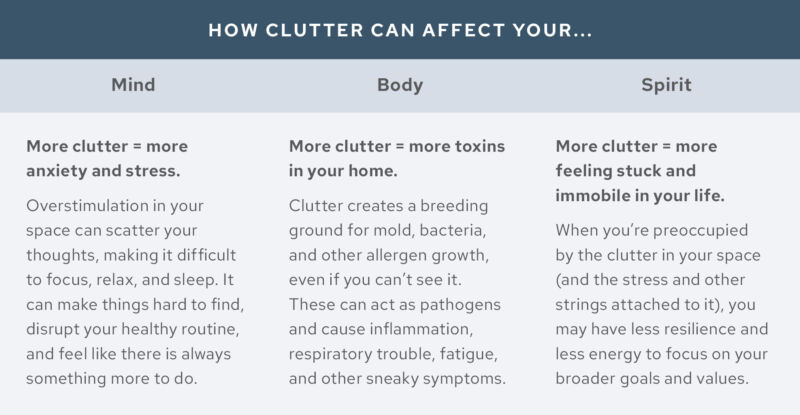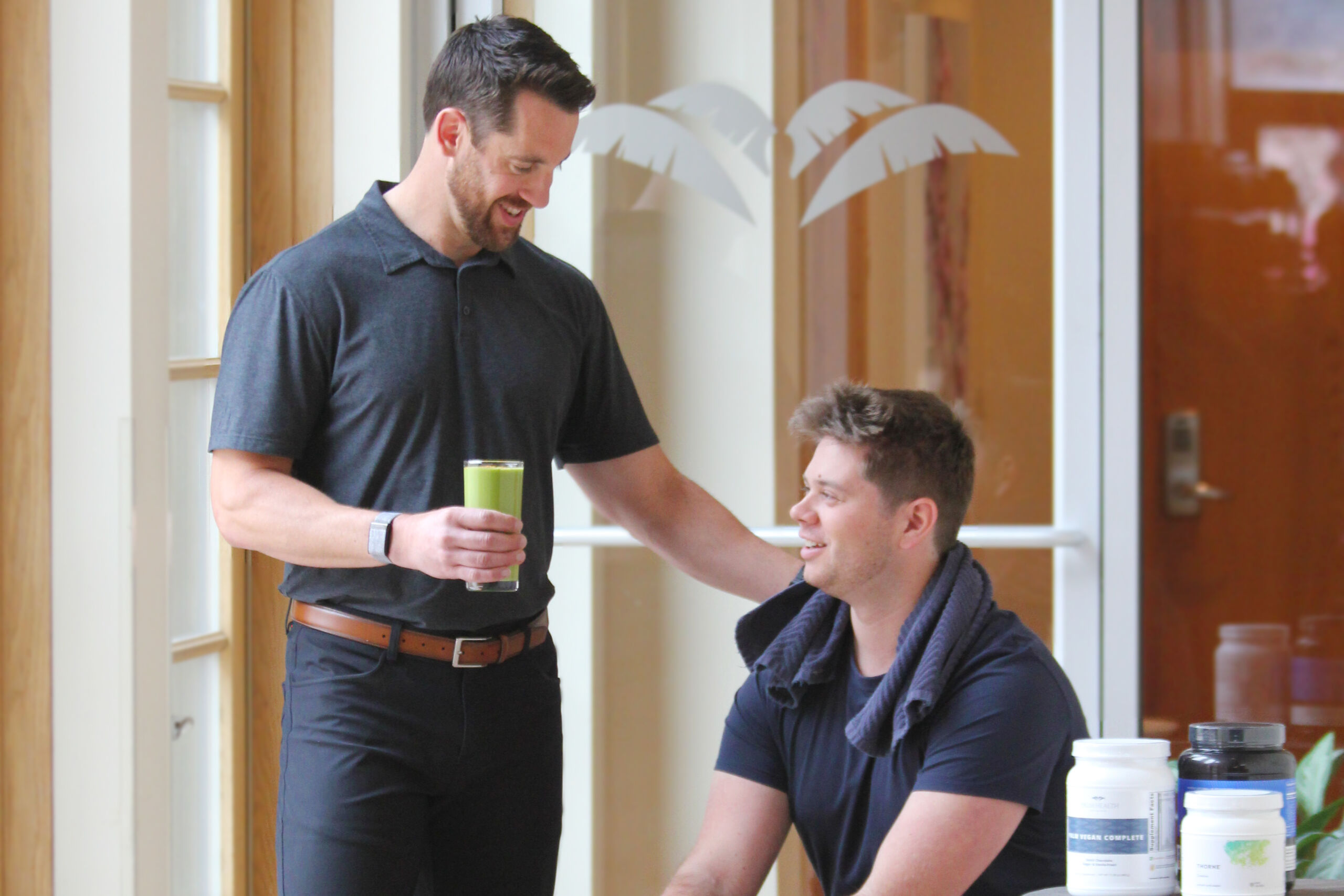Spring is a time of transition — the weather gets warmer, plants start blooming, and we all start to come out of our winter shells. That winter hibernation period can often leave us feeling cluttered, scattered, and stir-crazy, so what better time than spring to get organized and refocused?
Disorganization and clutter in your space can make you feel disorganized in your mind, body and spirit.
According to Julie Geeting, licensed therapist and well-being coach, “Getting curious about what’s behind the disorganization in your space and making an effort to change that can lead to a greater understanding of your mind, body, and spirit.”
As a part of that effort to change, decluttering and re-organizing your home is an important step in resetting and moving past the challenges that a messy environment can bring to each component of your being.
It can be a big project to undertake, but both the process and the outcome can help you feel less anxious, find peace and calm, save time, improve your circadian rhythms, and reduce toxin exposure. Plus, organizing brings order, which will allow you to be more resilient to challenges, focus more on what truly matters in your life, and have a positive effect on other people in your life.
Julie, along with home organization consultant Tracy Klebe, share their top tips for decluttering and re-establishing order in your home and your mind, body, and spirit.
1. Create a Master List.
Decluttering is often an overwhelming undertaking, so Tracy suggests always starting with a plan, or a Master List — capital “M”, capital “L.” This will serve as an inventory of every room or area you’d like to clean out or reorganize.
Once you have a master list, go through the items and prioritize them. Which room or area is the most pressing? Which can wait?
If you need a template to help you get started, check out Julie and Tracy’s Master List worksheet.
2. Put it on your calendar.
Projects like these are all too easy to push off and leave on the back burner. That’s why it helps to treat organizing as any other “appointment” and create a dedicated time for it on your calendar. Tracy recommends setting aside a couple of hours each week over the course of a few months or up to a year, if you can — and make those hours fun with an audiobook, podcast, or music (this is actually a proven technique for behavioral change)!
On the flip side, have you ever found yourself so engrossed in a project like this that before you know it, it’s 2:00am and you’re so deep into it that you haven’t eaten and you couldn’t possibly go to sleep?
“Scheduling time for your decluttering projects can also help you let go of them outside of that window, protect your bedtime, and keep a healthy routine,” says Julie.
3. Purge!
This is the toughest part of declutter, but also the most necessary. When purging, it’s important to be honest with yourself as to whether or not you actually need each item. In order to truly declutter and reorganize, you have to get rid of the things that don’t serve a purpose in your space or in your life.
You may have a hard time getting rid of some things, because everything in your home likely has some value to you, whether practical or sentimental — this is why it’s the toughest part!
One of Tracy’s favorite purging tips is to store certain items in trash bags in a corner or in your garage for a while, and if you haven’t used them or needed them after a couple of months, it may be a sign that it’s time to get rid of them.
4. Find a place for everything.
Oftentimes, what creates clutter is when you have a collection of things that don’t have a specific place. These things accumulate in corners, on top of tables, counters, and desks, and in closets.
The key is to find a place for everything you intend to keep. Sometimes that means sorting like items together and designating a specific bin or drawer for them, or it could be as simple as gathering up all of your pens and keeping them in one cup on your desk instead of scattered around every surface.
In order to designate a place for each item, Tracy recommends categorizing: sort your pantry items by food group, personal items by purpose, clothing by color or season, photos by albums for each year, and so forth. Find a method that makes sense for you.
5. Label it!
Your ability to organize and find things later will drastically improve if you are diligent with labeling. Once you have figured out how you want to sort and categorize things and where you want to keep them, label your bins, drawers, shelves, and cabinets. You can do this discreetly, or there are plenty of ways to make your labeling look intentional and stylish.
Use whatever containers you have to start. It’s important just to get organized first; then you can go about making it aesthetically pleasing.
How to Navigate the Emotional Challenge of Decluttering
Decluttering can come with many of its own challenges, which is why it can be such a demanding project. While for some, decluttering is more of a spring cleaning task as the seasons transition, for others, it often comes with big, difficult life transitions.
The loss of a loved one, aging parents, moving to a new home, or having children go off to college are all major life changes that can prompt the need to declutter. These kinds of transitions can make the project all the more emotionally challenging, and all the more necessary and healing.
If decluttering is a part of a bigger life change for you, you will likely experience a host of difficult thoughts and emotions throughout the process that can act as roadblocks in your path to moving forward. As you work to overcome these roadblocks, keep in mind these tidbits from Julie:
- Work with your stress rather than trying to get rid of it. Change, for better or for worse, brings stress. But stress brings growth. Try to approach that stress as a skill-building exercise — when it arrives, how will you work with it, rather than against it?
- Watch for and reframe unhelpful thought patterns. Rumination and avoidance are common traps, and important ones to look out for. Work on observing your thoughts objectively without condemning them, and when they don’t make you feel good, try to reframe them with the mindset of growth, appreciation, and acceptance so that you can ultimately let them go.
- Organization does not equal perfectionism. Perfectionism in a project like this can actually inhibit you from finishing, or even from getting started. Be cautious not to allow decluttering to become an obsession (tip #2 helps with this!).
- Remember that letting go of the past makes room for the possibilities of the future. Literally and figuratively. Look at what emotional attachments or strings you have to your material objects, and try to be honest about whether those are weighing you down in some way.
- Practice self-compassion along the way. “This is difficult work, but important work. It’s okay to ask for help with goal-setting, especially in the early stages of change,” says Julie.
Decluttering is not a simple fix — it’s really a deep dive and a fundamental change of order.
“Reorganizing your space is about creating sustainable, long-term change, and sustainable change requires consistency and commitment,” says Julie. The project itself takes commitment over a period of time to finish, but it also comes with the responsibility of sticking to the systems you put in place so that you stay organized in the future.
If you find yourself in need of extra support in getting started or sticking with it, booking a session with a well-being coach may be helpful. Your coach can help you set meaningful and realistic goals, hold you accountable throughout the process, and help you stay connected to the underlying value of this project in your life.
You can also schedule a TCI (Temperament and Character Inventory) Assessment in order to better understand your personality and in what areas you may experience stress, blockages, or challenges with a big project like decluttering.
The TCI is a comprehensive personality assessment developed by psychiatrist Dr. Robert Cloninger that measures four distinctive temperament traits and three character traits. The TCI paints a picture of your emotional drives and habits. With this information, you can better understand yourself and how you approach various situations in your life so you can ultimately overcome the things that challenge you.
Through May and June 2024, members can purchase a TCI Assessment and an interpretation with an expert for $125 at PALM ($165 value).
The process and outcome of reorganizing your space can bring about clarity, calm, and a renewed vitality to your life, especially in the face of transition and difficult change. Though it can feel overwhelming at times, it’s important to embrace the challenge along with all of its implications in order to emerge with a fresh perspective, space, and spirit. Happy decluttering!
PALM Health is an innovative lifestyle medicine and wellness center that offers a comprehensive range of advanced medical and wellness services, empowering people to transform their health and feel their best in mind and body.









